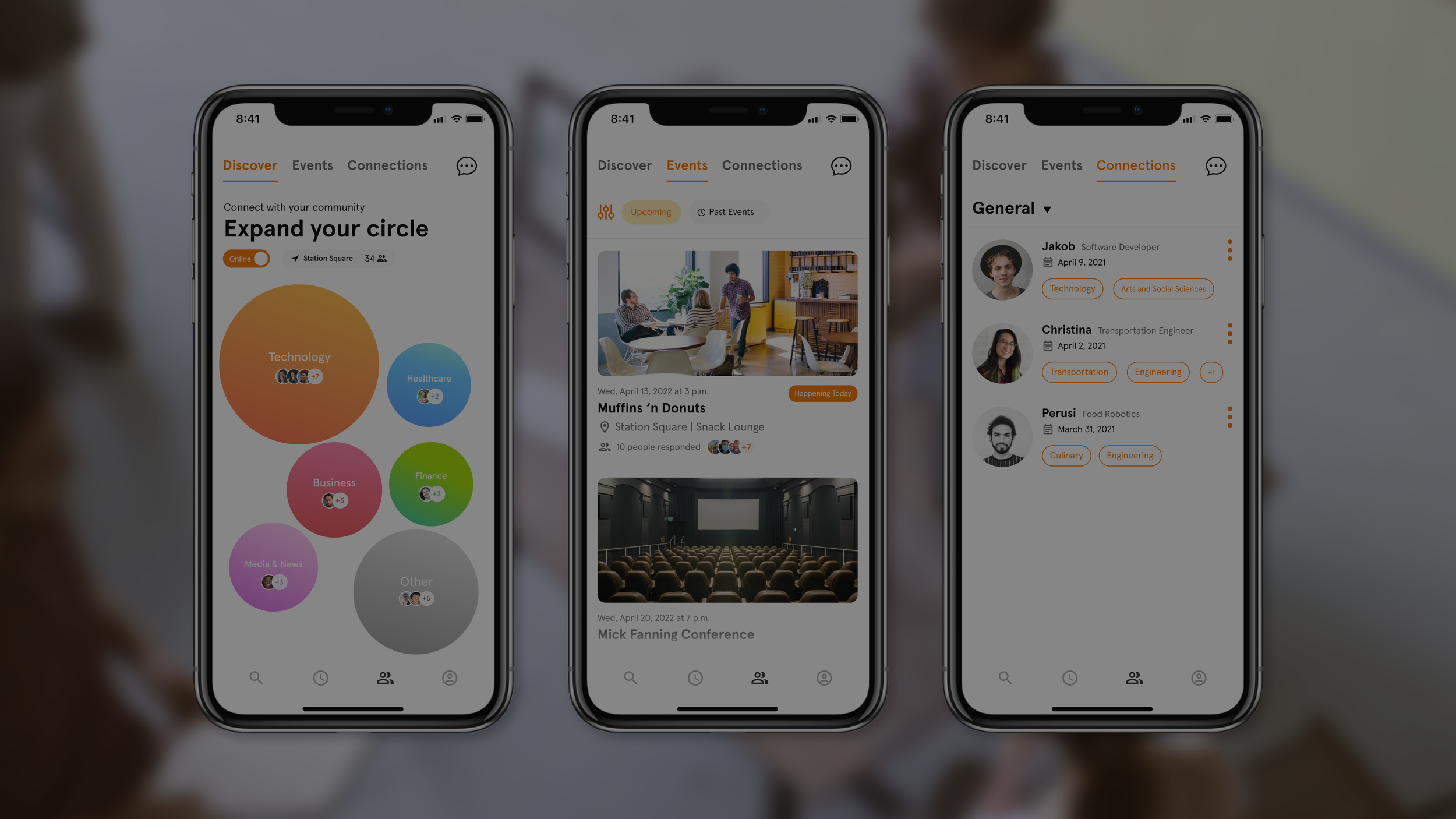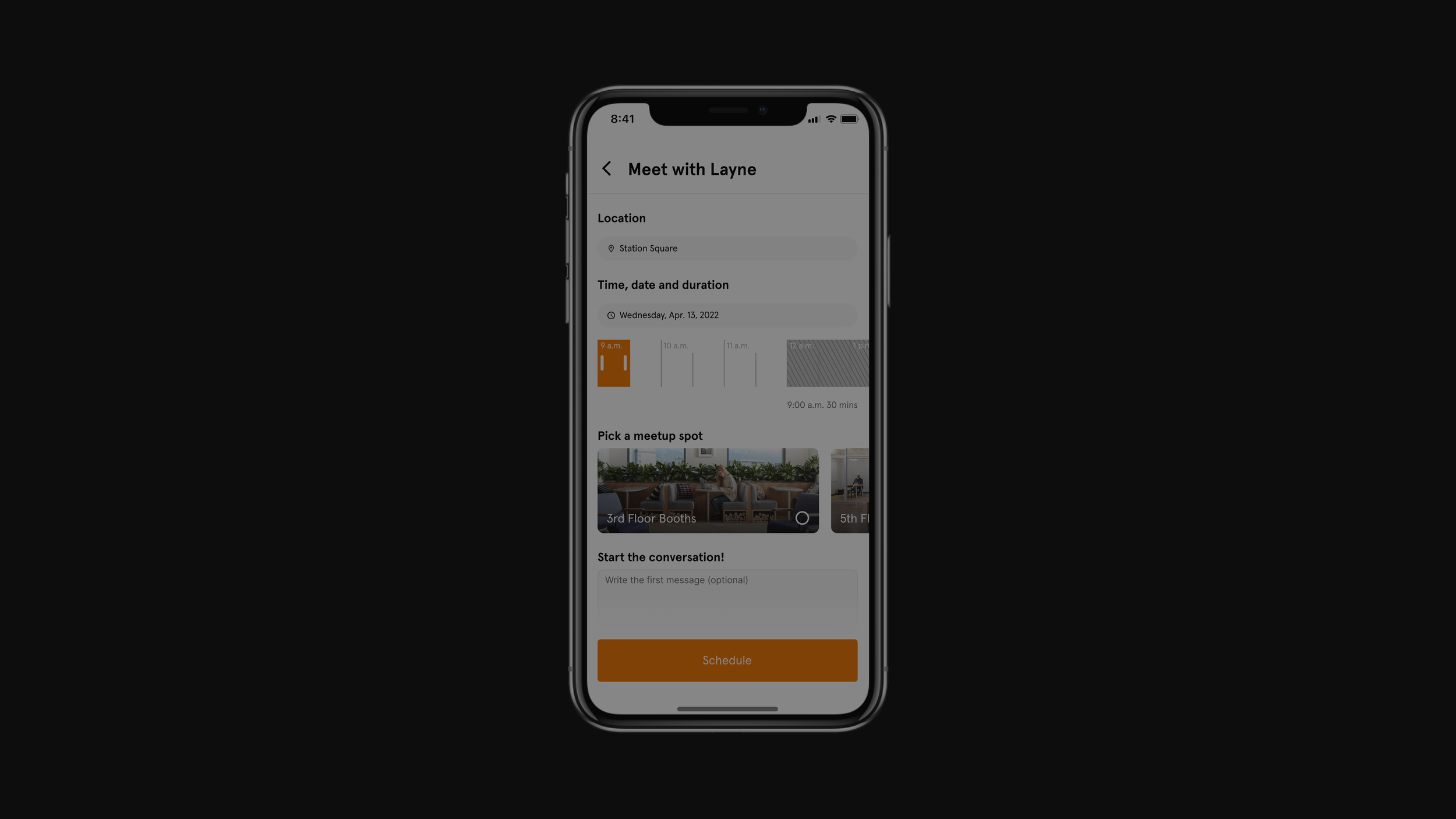Making networking easier within WeWork spaces
The Team
Emma Wu
Christian Lin
Kelvin Liew
Kitty Cheung
My Roles
Interface Design
Experience Design
Interaction Design
UX Research
Tools
Figma
Adobe Premiere
Time frame
5 Weeks, Spring 2022
This was a 5-week experience design project for a senior user experience design course at SFU. My team was tasked to find a client with an intervention opportunity. I led the team in research, framing, design sprint, and prototyping. WeWork Together is a digital experience that helps engage users with other WeWork members to grow their professional networks in the real world.
Our Client, WeWork
WeWork is one of the largest coworking companies having over 800 locations around the world. From driven freelancers to Fortune 500 companies anyone can find a workspace solution suitable for their goals. Each WeWork location has its own unique features that anyone with a membership subscription can access.
Positioning Within the Brand
After reviewing WeWork’s mission along with WeWork members’ thoughts and reviews regarding the company, the team found three main brand principles that would help build the foundations of our project:
Devotion to the community
Creating a WeWork community is simply just creating a culture for its members. Each city’s collection of WeWork offices leaves a general impression of what the community is like. Each location has its own unique quirks and attributes that have been shaped by community events and active members.
Collaboration helps everyone
The community aspect of coworking spaces has shown to be very beneficial to business owners; collaboration allows for new ideas, feedback, and faster problem-solving. This kind of joint effort to improve each other can be optimized at WeWork by taking advantage of communal spaces.
Accessible, functional, and flexible
WeWork offices house many freelancers and entrepreneurs that act as their own bosses. WeWork’s business model maximizes convenience for the user. These members are able to drop into any office workspace near their area and have access to the tools needed to complete their tasks.
Problem and Framing
“Connections with others are a big reason why people pay to work in a communal space, as opposed to working from home for free or renting a nondescript office.”
Upon reviewing online forums, blog posts, and academic journal articles, we found that signing up for a WeWork membership goes beyond just “having a place to do work”. Networking revealed itself to be one of the top reasons for people to use coworking spaces. Yet, it is apparent that the social aspects of each WeWork location are inconsistent with each subsequent location. Community events at WeWork give a chance for members to connect with one another, but the quality and frequency of these events vary depending on the location and community managers.
“The spaces in India were not as welcoming whereas the locations in Berlin seem more social.”
Our team interviewed 5 WeWork members to gain insights into each person’s perspective on networking and community within WeWork office spaces. We found that social engagement in workspaces tends to be limited since members are often too busy with work or want to avoid interrupting other people’s workflow. Often times a visit to a WeWork office would end up with the member keeping to themselves and respecting the space and privacy of other people. Using the interview insights and the information we learned from our secondary research, we were able to frame a design problem:
How might we leverage WeWorks app and workspaces to support members in networking within the WeWork community?
The goal is to connect with new colleagues in WeWork coworking spaces. Plan meetups, find events, and get involved in a local professional community — all within a schedule that works for the user.
SOLUTION
WeWork Together
A use case video showcasing key components of the WeWork Together feature.
WeWork Together: Break Down
Finding your Network
The landing screen for WeWork Together displays a live count of who is at the selected WeWork location. With the assigned colours for each sector and the proportional sizes of the bubbles, users can easily parse through different locations in their city. The discoverability of the user can be changed in the app settings or on the Discover screen using the online/offline toggle. Photos of community members appear within each sector bubble, which feels more personable and human.
A new way to discover people in your industry.
Staying active with the community
The current method to explore events is through WeWork’s web portal. With WeWork together, members will be able to explore events in the WeWork app. Event details will include a brief description of the event and a data visualization of the attendees’ industries to assist the user in gauging their own interests.
Creating opportunities to connect with other WeWork event attendees.
Events can also be explored through the map view. Selecting a WeWork location shows available events to attend.
Users can find the right event for them by checking what industry attendees are from.
After attending an event, users will be notified through a popup that they can revisit the list of attendees. This is an intuitive way for users to see at a glance, who they might be interested in connecting with going forward. Other past events that the user has attended can always be accessed through the Events tab as well.
Guiding you into real-world connections
The goal for WeWork Together was to kickstart the connecting process within WeWork spaces, but my team did not want it to be used as a social media app. The chat feature only functions as a way to communicate details about meetups such as exact locations and confirmations; this feature is only accessible through the WeWork Together section of the app.
A functional chat meant to help users plan their meetups.
Usually, on a social media or networking platform, users add each other to their online network before meeting up or chatting. Upon user-testing, we found that this “add first, chat after” process made WeWork Together feel like a social media platform. A “set up meeting, chat after, add later (externally)” process was implemented to help differentiate itself from social media platforms.
Scheduling a meetup is easy and done through the app.
Scheduling a meeting is required when making a connection; this helps promote real-life engagement and prevents users from using the WeWork app for just online connections. Meetings can be rescheduled or canceled if needed.
Connections can be managed as needed.
Managing WeWork Together connections is split into three categories to limit cognitive overhead: Upcoming, Pending, and General. Here, users can check members’ profiles, start conversations, or remove connections.







